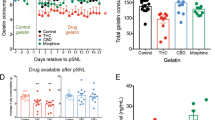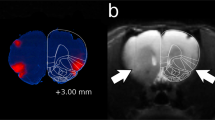Abstract
Rationale
Recent animal studies reported that curcumin, the active constituent of Curcuma longa, has several central actions and may attenuate morphine tolerance.
Objectives
In the present study, we utilized the intracranial self-stimulation (ICSS) paradigm to examine the effects of the commercially available curcuminoid mixture and each one of its components, individually, on brain stimulation reward and on the reward-facilitating effect of morphine.
Methods
Male Sprague-Dawley rats were implanted with an electrode into the medial forebrain bundle and trained to respond for electrical stimulation using a rate-frequency paradigm. In the first study, rats were injected with graded doses either of the curcuminoid mixture, or curcumin I, or II, or III. In the second study, we examined whether a low dose of the curcuminoid mixture or each individual curcumin analogue composing it could counteract the reward-facilitating effect of morphine.
Results
At low doses, both the curcuminoid mixture and curcumin I did not affect brain stimulation reward, whereas, higher doses increased ICSS thresholds. Curcumin II and curcumin III did not affect brain stimulation reward at any doses. Subthreshold doses of the curcuminoid mixture and curcumin I inhibited the reward-facilitating effect of morphine.
Conclusion
Both the curcuminoid mixture and curcumin I lack hedonic properties and moderate the reward-facilitating effect of morphine. Our data suggest that curcumin interferes with brain reward mechanisms responsible for the expression of the acute reinforcing properties of opioids and provide evidence that curcumin may be a promising adjuvant for attenuating morphine’s rewarding effects in patients who are under long-term opioid therapy.






Similar content being viewed by others
References
Aggarwal BB, Sung B (2009) Pharmacological basis for the role of curcumin in chronic diseases: an age-old spice with modern targets. Trends Pharmacol Sci 30:85–94
Aggarwal BB, Sundaram C, Malani N, Ichikawa H (2007) Curcumin: the Indian solid gold. Adv Exp Med Biol 595:1–75
Agrawal SS, Gullaiya S, Dubey V, Singh V, Kumar A, Nagar A, Tiwari P (2012) Neurodegenerative shielding by curcumin and its derivatives on brain lesions induced by 6-OHDA model of Parkinson’s disease in albino Wistar rats. Cardiovasc Psychiatry Neurol 2012:942981
Altarifi AA, Negus SS (2011) Some determinants of morphine effects on intracranial self-stimulation in rats: dose, pretreatment time, repeated treatment, and rate dependence. Behav Pharmacol 22:663–673
Anand P, Thomas SG, Kunnumakkara AB, Sundaram C, Harikumar KB, Sung B, Tharakan ST, Misra K, Priyadarsini IK, Rajasekharan KN, Aggarwal BB (2008) Biological activities of curcumin and its analogues (congeners) made by man and Mother Nature. Biochem Pharmacol 76:1590–1611
Ballantyne JC, LaForge KS (2007) Opioid dependence and addiction during opioid treatment of chronic pain. Pain 129:235–255
Ballantyne JC, Mao J (2003) Opioid therapy for chronic pain. N Engl J Med 349:1943–1953
Bhutani MK, Bishnoi M, Kulkarni SK (2009) Anti-depressant like effect of curcumin and its combination with piperine in unpredictable chronic stress-induced behavioral, biochemical and neurochemical changes. Pharmacol Biochem Behav 92:39–43
Campbell KA, Evans G, Gallistel CR (1985) A microcomputer-based method for physiologically interpretable measurement of the rewarding efficacy of brain stimulation. Physiol Behav 35:395–403
Carey RJ, DePalma G, Damianopoulos E, Shanahan A, Muller CP, Huston JP (2005) Evidence that the 5-HT1A autoreceptor is an important pharmacological target for the modulation of cocaine behavioral stimulant effects. Brain Res 1034:162–171
Carlezon WA Jr, Chartoff EH (2007) Intracranial self-stimulation (ICSS) in rodents to study the neurobiology of motivation. Nat Protoc 2:2987–2995
Carlezon WA Jr, Wise RA (1993) Morphine-induced potentiation of brain stimulation reward is enhanced by MK-801. Brain Res 620:339–342
Chiappedi M, Bejor M (2010) Herbals and natural dietary supplements in psychiatric practice. Recent Pat CNS Drug Discov 5:164–171
Dao JM, McQuown SC, Loughlin SE, Belluzzi JD, Leslie FM (2011) Nicotine alters limbic function in adolescent rat by a 5-HT1A receptor mechanism. Neuropsychopharmacology 36:1319–1331
Edmonds DE, Gallistel CR (1974) Parametric analysis of brain stimulation reward in the rat: III. Effect of performance variables on the reward summation function. J Comp Physiol Psychol 87:876–883
Elmer GI, Pieper JO, Hamilton LR, Wise RA (2010) Qualitative differences between C57BL/6 J and DBA/2 J mice in morphine potentiation of brain stimulation reward and intravenous self-administration. Psychopharmacology (Berl) 208:309–321
Ewan EE, Martin TJ (2011) Opioid facilitation of rewarding electrical brain stimulation is suppressed in rats with neuropathic pain. Anesthesiology 114:624–632
Fiala M, Liu PT, Espinosa-Jeffrey A, Rosenthal MJ, Bernard G, Ringman JM, Sayre J, Zhang L, Zaghi J, Dejbakhsh S, Chiang B, Hui J, Mahanian M, Baghaee A, Hong P, Cashman J (2007) Innate immunity and transcription of MGAT-III and Toll-like receptors in Alzheimer’s disease patients are improved by bisdemethoxycurcumin. Proc Natl Acad Sci U S A 104:12849–12854
Goel A, Kunnumakkara AB, Aggarwal BB (2008) Curcumin as “Curecumin”: from kitchen to clinic. Biochem Pharmacol 75:787–809
Harrison AA, Markou A (2001) Serotonergic manipulations both potentiate and reduce brain stimulation reward in rats: involvement of serotonin-1A receptors. J Pharmacol Exp Ther 297:316–325
Hojsted J, Sjogren P (2007) Addiction to opioids in chronic pain patients: a literature review. Eur J Pain 11:490–518
Hui B, Wang W, Li J (2010) Biphasic modulation of cocaine-induced conditioned place preference through inhibition of histone acetyltransferase and histone deacetylase. Saudi Med J 31:389–393
Jiang H, Wang Z, Wang Y, Xie K, Zhang Q, Luan Q, Chen W, Liu D (2013) Antidepressant-like effects of curcumin in chronic mild stress of rats: involvement of its anti-inflammatory action. Prog Neuropsychopharmacol Biol Psychiatry 47:33–39
Katsidoni V, Apazoglou K, Panagis G (2011) Role of serotonin 5-HT2A and 5-HT2C receptors on brain stimulation reward and the reward-facilitating effect of cocaine. Psychopharmacology (Berl) 213:337–354
Katsidoni V, Anagnostou I, Panagis G (2013) Cannabidiol inhibits the reward-facilitating effect of morphine: involvement of 5-HT1A receptors in the dorsal raphe nucleus. Addict Biol 18:286–296
Kenny PJ (2007) Brain reward systems and compulsive drug use. Trends Pharmacol Sci 28:135–141
Kulkarni SK, Bhutani MK, Bishnoi M (2008) Antidepressant activity of curcumin: involvement of serotonin and dopamine system. Psychopharmacology (Berl) 201:435–442
Matsushita Y, Ueda H (2009) Curcumin blocks chronic morphine analgesic tolerance and brain-derived neurotrophic factor upregulation. Neuroreport 20:63–68
McQuay H (1999) Opioids in pain management. Lancet 353:2229–2232
Miliaressis E, Rompre PP (1987) Effects of concomitant motor reactions on the measurement of rewarding efficacy of brain stimulation. Behav Neurosci 101:827–831
Miliaressis E, Rompre PP, Laviolette P, Philippe L, Coulombe D (1986) The curve-shift paradigm in self-stimulation. Physiol Behav 37:85–91
Mittal N, Joshi R, Hota D, Chakrabarti A (2009) Evaluation of antihyperalgesic effect of curcumin on formalin-induced orofacial pain in rat. Phytother Res 23:507–512
O’Neill KS, Todtenkopf MS (2010) Using a rate-frequency curve method to assess the rewarding properties of morphine in the intracranial self-stimulation paradigm in rats. J Neurosci Methods 189:75–79
Rinwa P, Kumar A, Garg S (2013) Suppression of neuroinflammatory and apoptotic signaling cascade by curcumin alone and in combination with piperine in rat model of olfactory bulbectomy induced depression. PLoS ONE 8:e61052
Robinson JE, Fish EW, Krouse MC, Thorsell A, Heilig M, Malanga CJ (2012) Potentiation of brain stimulation reward by morphine: effects of neurokinin-1 receptor antagonism. Psychopharmacology (Berl) 220:215–224
Sagnou M, Mitsopoulou KP, Koliopoulos G, Pelecanou M, Couladouros EA, Michaelakis A (2012) Evaluation of naturally occurring curcuminoids and related compounds against mosquito larvae. Acta Trop 123:190–195
Schmitz A, Kirsch P, Reuter M, Alexander N, Kozyra E, Kuepper Y, Osinsky R, Hennig J (2009) The 5-HT1A C(-1019)G polymorphism, personality and electrodermal reactivity in a reward/punishment paradigm. Int J Neuropsychopharmacol 12:383–392
Sharma S, Kulkarni SK, Agrewala JN, Chopra K (2006) Curcumin attenuates thermal hyperalgesia in a diabetic mouse model of neuropathic pain. Eur J Pharmacol 536:256–261
Shen H, Hu X, Szymusiak M, Wang ZJ, Liu Y (2013) Orally Administered nanocurcumin to attenuate morphine tolerance: comparison between negatively charged PLGA and partially and fully PEGylated nanoparticles. Mol Pharm 10:4546–4551
Tajik H, Tamaddonfard E, Hamzeh-Gooshchi N (2008) The effect of curcumin (active substance of turmeric) on the acetic acid-induced visceral nociception in rats. Pak J Biol Sci 11:312–314
Tomren MA, Masson M, Loftsson T, Tonnesen HH (2007) Studies on curcumin and curcuminoids XXXI. Symmetric and asymmetric curcuminoids: stability, activity and complexation with cyclodextrin. Int J Pharm 338:27–34
Tzchentke TM, Schmidt WJ (2000) Effects of the non-competitive NMDA-receptor antagonist memantine on morphine- and cocaine-induced potentiation of lateral hypothalamic brain stimulation reward. Psychopharmacology (Berl) 149:225–234
Vlachou S, Markou A (2011) The use of the intracranial self-stimulation in drug abuse research. In: Olmstead MC (ed) Animal models of drug addiction Neuromethods, vol 53. Humana Press and Springer Science, New York, pp 3–56
Wang R, Xu Y, Wu HL, Li YB, Li YH, Guo JB, Li XJ (2008) The antidepressant effects of curcumin in the forced swimming test involve 5-HT1 and 5-HT2 receptors. Eur J Pharmacol 578:43–50
Wise RA (1996) Addictive drugs and brain stimulation reward. Annu Rev Neurosci 19:319–340
Zhao C, Lou Z, Zimmer B, Yu Z, Li P, Ma B, Sun Y, Huang K, Zhou W, Liu Y (2012a) Chronic treatment with curcumin enhances methamphetamine locomotor sensitization and cue-induced reinstatement of methamphetamine self-administration. Pharmacol Biochem Behav 102:555–561
Zhao X, Xu Y, Zhao Q, Chen CR, Liu AM, Huang ZL (2012b) Curcumin exerts antinociceptive effects in a mouse model of neuropathic pain: descending monoamine system and opioid receptors are differentially involved. Neuropharmacology 62:843–854
Zhao X, Wang C, Zhang JF, Liu L, Liu AM, Ma Q, Zhou WH, Xu Y (2013) Chronic curcumin treatment normalizes depression-like behaviors in mice with mononeuropathy: involvement of supraspinal serotonergic system and GABA receptor. Psychopharmacology (Berl)
Zhou H, Beevers CS, Huang S (2011) The targets of curcumin. Curr Drug Targets 12:332–347
Acknowledgments
The authors would like to specially thank Prof. G. Paxinos for his kind financial support. This study was also supported by the Department of Psychology of the University of Crete. Acknowledgements also to the City Unity College, Department of Psychology, Athens, Greece for facilitating this collaboration. The experiments reported comply with the European Community Council Directive (86/609/EEC).
Conflict of interest
The authors report no conflicts of interest.
Author information
Authors and Affiliations
Corresponding author
Rights and permissions
About this article
Cite this article
Katsidoni, V., Alexiou, P., Fotiadou, M. et al. Curcumin, demethoxycurcumin and bisdemethoxycurcumin differentially inhibit morphine's rewarding effect in rats. Psychopharmacology 231, 4467–4478 (2014). https://doi.org/10.1007/s00213-014-3603-5
Received:
Accepted:
Published:
Issue Date:
DOI: https://doi.org/10.1007/s00213-014-3603-5




